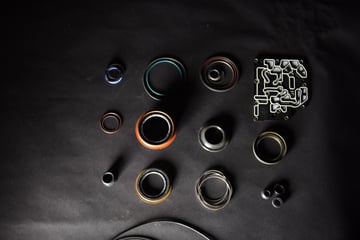How Industry Forecasting Leads to Better Transmission Overhaul Kit Coverage
 Aftermarket kit providers have their work cut out for them when it comes to developing transmission overhaul kits and getting the right ones into the hands of rebuilders. Unfortunately, original equipment manufacturers (OEMs) don't release a convenient list of their applications and when they need to be serviced or rebuilt. Kit providers can only determine that information from research and analysis of the industry data available to them. And in the end, not all kit providers choose to put in the time and effort it takes to anticipate which kits rebuilders need and when.
Aftermarket kit providers have their work cut out for them when it comes to developing transmission overhaul kits and getting the right ones into the hands of rebuilders. Unfortunately, original equipment manufacturers (OEMs) don't release a convenient list of their applications and when they need to be serviced or rebuilt. Kit providers can only determine that information from research and analysis of the industry data available to them. And in the end, not all kit providers choose to put in the time and effort it takes to anticipate which kits rebuilders need and when.
Those that do choose to improve their development process using forecasting techniques, however, pass that value on to the rebuilder. In this post, we'll explain how industry forecasting leads to better transmission overhaul kit coverage and describe a few of the resources that quality kit providers use to prioritize their development schedule.
The Benefits of Forecasting in the Overhaul Kit Development Process
In general, the benefits of using industry data to forecast which transmission overhaul kits rebuilders will need all relate back to time and preparedness. When your kit provider uses advanced research and forecasting, here's what happens:
 Real data helps to prioritize the kit development schedule. The main goal of analyzing forecast data for the kit provider is to learn when transmissions and vehicles are coming out of their warranties. With this information, along with other research and industry knowledge, the provider can prioritize which kits to begin development on first. While organizing the actual development schedule for all kits (as well as each individual kit) can be a complex process, having the forecasting to create firm deadlines and back up the logic of that schedule helps keep the provider's development strategy justified and on track.
Real data helps to prioritize the kit development schedule. The main goal of analyzing forecast data for the kit provider is to learn when transmissions and vehicles are coming out of their warranties. With this information, along with other research and industry knowledge, the provider can prioritize which kits to begin development on first. While organizing the actual development schedule for all kits (as well as each individual kit) can be a complex process, having the forecasting to create firm deadlines and back up the logic of that schedule helps keep the provider's development strategy justified and on track.- Overhaul kits are ready long before you can expect to need them. Another benefit of industry forecasting during the development process is actually the direct result of prioritizing the development schedule. Given that the provider knows when each new transmission application is coming out of warranty, and if the forecasting is done far enough ahead of time, the provider has the opportunity to ensure that overhaul kits are ready far in advance of potential service. In some cases, providers can have kits ready for a transmission as early as just two years after the application is released — long before any rebuilder is likely to even see it in the shop. When you use a provider that employs advanced forecasting methods, there's no waiting necessary; the kit you need will always be ready, even in the unlikely event that the warranty isn't up yet.
- Development and rebuilding challenges are already accounted for upon release. Finally, forecasting for kit development allows providers to get a huge head start on producing overhaul kits for newer transmission applications in a way that allows for a larger window of time to address potential development and rebuilding challenges. Solutions to issues with sourcing, production, design, packaging, and more can be worked out long before the kit goes to market, thanks to the advance notice of forecast data. Not only will rebuilders receive kits as soon as they're needed, but there's a far smaller risk that's something wrong or missing in the kit.
Transmission Industry Forecasting Resources
 Kit providers in the transmission industry collect forecast data from a variety of sources depending on what's available to them. It's important to recognize that not every kit provider has the same resources or connections on hand to help gather and analyze the information that helps the brand foresee which applications to develop next. For a kit provider with a well-developed forecasting process, here are some of the main resources that factor in:
Kit providers in the transmission industry collect forecast data from a variety of sources depending on what's available to them. It's important to recognize that not every kit provider has the same resources or connections on hand to help gather and analyze the information that helps the brand foresee which applications to develop next. For a kit provider with a well-developed forecasting process, here are some of the main resources that factor in:
- Historical production statistics and data
- Production numbers
- Customer data
- Information and insights from OEMs
In particular, the kit providers with strong ties to OEMs and parent companies have a significant advantage when it comes to forecasting. When the provider has a direct view into what the OEMs are developing and releasing, their research is more in-depth and even further expedited in a way that other aftermarket kit brands cannot replicate.
Providers will feed this information into a unique calculator tool or system that indicates which applications should take priority in their development schedule. Therefore, providers that take the time to forecast applications using this data are constantly releasing new kits, and in the end, they tend to cover a much higher percentage of vehicles on the road than other brands can. And when the vehicles on the road are covered, that means you can service them without waiting or worry. While it's only part of the development process, the forecasting step is an incredibly significant element that you should be sure your kit provider takes the time to incorporate.


